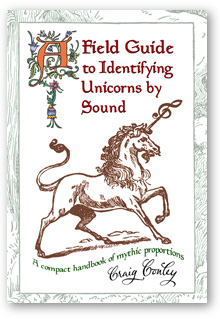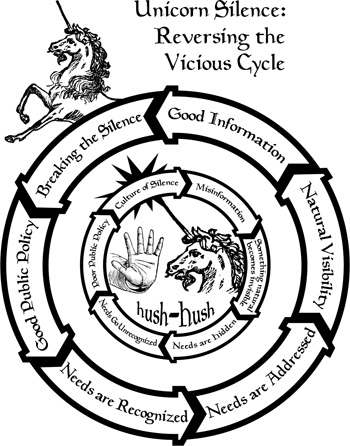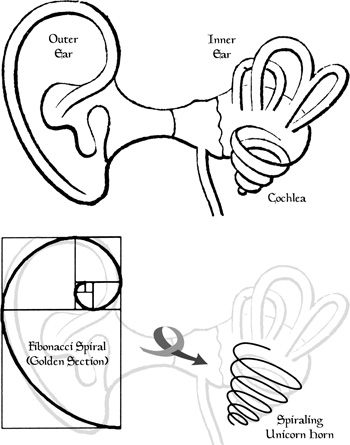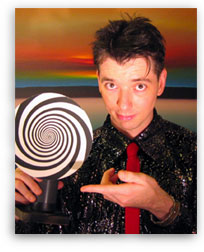|

|
There are many ways to detect the presence of a unicorn in your own backyard, without the need for expensive electronic equipment (leave that to the greenhorn rangers) or a virgin maid (leave her to the hopeless romantics). The most obvious is via the faculty of sight. When conditions of poor visibility preclude this approach, the “third eye” of intuition is commonly employed to track down the elusive beast. This book, however, focuses on the immense potential of the human ear. It is a little-known fact that, with listening practice, the human ear can be a peerless tool for perceiving unicorns. (The converse principle—that the unicorn ear is a peerless tool for perceiving humans—is, if true, a fact so little-known as to be undocumented.) Even those unicorn fanciers with hearing loss or profound deafness will benefit from the wealth of knowledge contained herein. Just as our old friend the blind Mexican cave fish (astyanax hubbsi) responds to moving visual stimuli, the human ear responds to unicorn sounds—even to those unicornian vibrations that are technically outside the range of one’s hearing. This book weaves precious bits and pieces of evidence like a Celtic braid, gathering from a wide variety of sources: chronicles of yore, modern-day eyewitness accounts, oral histories and folk traditions, and, of course, myths and legends from around the world. These testaments are not intended to stand as scientific proof of unicorns. On the contrary, they paint a far grander picture than the tight rein of science can fabricate. It is the intention of this book to beguile your eardrums with the rhythmic hoofbeats, melodic whinnies, wistful sighs, and even bated breaths of the majestic unicorn. And when the book ends, its story will continue. For the final chapter of our saga will be yours to tell, based upon your own unforgettable first-hand experiences. PRAISE FOR A FIELD GUIDE TO IDENTIFYING UNICORNS BY SOUND  “Delightful.”
“Delightful.” “A great treat.” “Hilarious!” “Definitely a good reference to keep handy.” “A really wonderful book.” “Brilliant! I read it as a stylistically sly and wonderfully evocative poem. A riot for the senses.” “This is remarkable . . . I’ve sometimes thought I have seen or been in the presence of unicorns, but now I have the skills to actually seek them out! What a revelation. My favourite parts were ‘Practice keeping an ear out for . . . an improbable tinkling of wind chimes . . . [and] a flatted fifth from an uninvited trombone’ from Chapter 1.” “Today’s reading for the slightly off-center gardener . . . You wouldn’t want to miss knowing you had a unicorn in your garden simply because you weren’t listening.” “One-of-a-kind. ‘Innocent appearing’ sputtering wit and sense of absurdity. The ‘Field Guide’ is a wonderful gift. Its subject is perfect. Everyone loves unicorns; they are acutely sympatico and don’t age. A hundred years from now, the book will be just as funny.” “Marked by humor, a broad literary erudition and a marvelous sense of the absurd.” “This could change my life forever.” “A very lovely book to own and keep forever.”  “The book is nothing if not thorough in reproducing what seems to be everything ever said anywhere in literature pertaining to the sounds made by unicorns. Listening for all of these will charge your humdrum, everyday reality with magic, or at least give it some zip. Conley’s omission of the many references to the unicorn in the King James Bible, however, is a puzzler (see Nu 23:22; 24:8; Dt 33:17; Job 39: 9-12; Pss 22:21; 29:6; 92:10; Isa 34:7). Surely Conley knows that fundamentalist champions of the KJV in their millions would find themselves theologically bound to agree with him in presuming the existence of unicorns. Was this deliberate? And if so, was the omission a contemptuous snub or a gesture of respect? I’m almost tempted to deduct a star, but I’m going to take this as a refusal to divide his audience by religion, seeing as how fundamentalist bashers are at least as vocal and nasty as the worst of their targets, and it would be difficult to hear even the clumsiest unicorn over the cantankerous clatter that could result.”
“The book is nothing if not thorough in reproducing what seems to be everything ever said anywhere in literature pertaining to the sounds made by unicorns. Listening for all of these will charge your humdrum, everyday reality with magic, or at least give it some zip. Conley’s omission of the many references to the unicorn in the King James Bible, however, is a puzzler (see Nu 23:22; 24:8; Dt 33:17; Job 39: 9-12; Pss 22:21; 29:6; 92:10; Isa 34:7). Surely Conley knows that fundamentalist champions of the KJV in their millions would find themselves theologically bound to agree with him in presuming the existence of unicorns. Was this deliberate? And if so, was the omission a contemptuous snub or a gesture of respect? I’m almost tempted to deduct a star, but I’m going to take this as a refusal to divide his audience by religion, seeing as how fundamentalist bashers are at least as vocal and nasty as the worst of their targets, and it would be difficult to hear even the clumsiest unicorn over the cantankerous clatter that could result.” “Craig Conley is a true Renaissance man of the modern era, diving headfirst into comprehensive, open-minded study of realms obscured or merely obscure. A voracious researcher, he possesses both the focus required to compile book-length arcana on a given topic and the objectiveness to consider sources other scholars might ignore. It is precisely this tendency to ‘overlook’ that forms the basis for Conley’s Field Guide. As he states in the book’s introduction, ‘Because we live in a highly visual world, we rarely exercise the full range of our hearing. Yet our ears can detect things that our eyes automatically reject. By listening as opposed to looking, we can avoid overlooking. Practice can be richly rewarding, whether one is listening for unicorns in particular or neglected delights in general.’ And so Conley mines the known literature on unicorns, nobly eschewing distinctions between historical accounts, fantasy novels, and instances of metaphor, organizing the brief excerpts and other tidbits found into 51 short lessons in the art of ‘deep listening’ necessary to perceive the fabulous beasts. Soundwave diagrams impart insight into such audible tendencies of the unicorn as rustling, laughter, mimicry of orchestral instruments, soft nickering, cries of ruin, and the creature’s alarm ‘sneeze.’ More complex diagrams contribute to the remapping of the once well-maintained highways between magic and science, illuminating such correspondences as the Fibonacci Spiral with the shape of the outer ear and the comparative curl of the unicorn’s horn with that of the human cochlea. Conley also offers a companion compact disc with four tracks of listening exercises set in a sylvan soundscape.” “I’ve always been inclined to assume that I have never seen a unicorn, but I hadn’t even finished reading the introduction when my assumption was challenged by a simple question: ‘How many bird watchers have spied a warbler perched upon a tapered branch, never dreaming that the selfsame branch is, in actuality, a unicorn’s horn?’ It’s a problem. Vision is an unreliable tool under the best conditions, and as the author points out, ‘there are great odds that a unicorn will approach from one of your many blind spots.’ This, of course, to remind us that the most troublesome blind spot of all — in the center of our field of vision, where the optic nerve is connected — is filled in by the brain. Thus, the mind that rejects the existence of unicorns is unlikely to fill that empty optical space with a unicorn. This leaves sound as the only reliable ally. More than a collection of unicorn-sound waveforms and beyond its value as a compendium of unicorn knowledge, the book calls on us to stare with our ears, as Ken Nordine intended. ‘My unicorn can whisper strange things when I want him to, and sometimes when I don’t.’ —Larry Niven, as quoted in A Field Guide to Identifying Unicorns by Sound.” |
|||||||||||||||||||||||||||||||||||||||||||||
 |
About the AuthorCraig Conley is a magic enthusiast and scholar. Recognized by Encarta as “America’s most creative and diligent scholar of letters, words and punctuation,” his intensive and eccentric research has led him to compile a true masterwork entitled Magic Words: A Dictionary. He has also authored One-Letter Words: A Dictionary, among other strange and unusual lexicons, and is a regular columnist for Pentacle magazine. Conley’s ideas are often decades ahead of their time. He invented the concept of the “virtual pet” in 1980, fifteen years before the debut of the popular “Tamagotchi” in Japan. His virtual pet, actually a rare flower, still thrives and has reached an incomprehensible size. Featured Works: Published Works |
|||||||||||||||||||||||||||||||||||||||||||||
|
|
Online Resources |
|||||||||||||||||||||||||||||||||||||||||||||
A free daily symbolic outlook
|
||||||||||||||||||||||||||||||||||||||||||||||